Memories of Myron
The Passing of a Psychedelic Pioneer
(Aug 20, 1920-Jan 6, 2013)
Jan 31, 2013
Citation: Hanna, J. "Memories of Myron: The Passing of a Psychedelic Pioneer". Erowid.org. Jan 31, 2013.
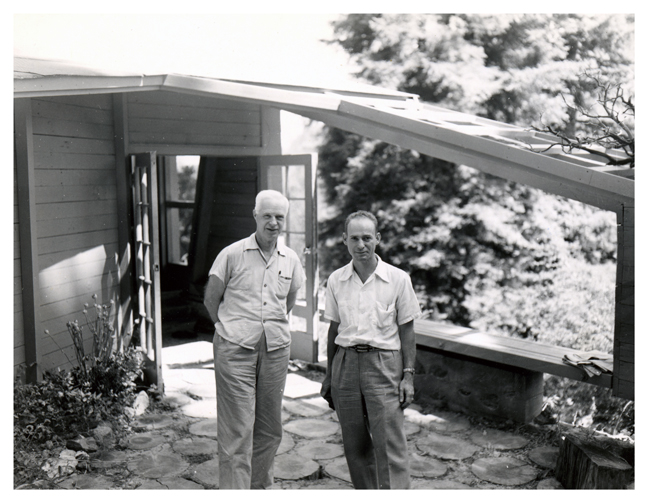
|
THE EARLY DAYS
Myron got excellent marks in school and received his Master's degree in Electrical Engineering from Stanford University. While working for the Ampex Corporation, he and Harold Lindsay co-designed the company's first magnetic tape recorder. In 1948, this machine was used by ABC to pre-record The Bing Crosby Show, negating the need to produce the show live. Delayed broadcast of a radio program had never been done before; the new approach ushered in dramatic industry-wide changes.Once while visiting Myron in Lone Pine, I asked about a photograph in his house of the guitarist Les Paul, renowned for developing the solid-body guitar. It turned out that Les and Myron got to know each other after Bing Crosby had given Les one of his Ampex recorders. With that machine, Les began his innovations in multi-track recordings, for which he received a Technical GRAMMY Award in 2001. Seven years later, at the 50th annual GRAMMYs, Myron was among those who accepted a Technical GRAMMY Award for Ampex.
SEEKING SPIRIT
Despite his intelligence, as a young man Myron often viewed himself as being neurotic and unhappy. Having a logical mind, he began looking for something that might change his feelings of dissatisfaction. An interest in spirituality began in his 30s, after he became involved with the Sequoia Seminar. This organization, run by Harry and Emelia Rathbun, suggested that human potential might be improved by studying the teachings of Jesus. Though Jewish by birth, Myron was impressed with the Rathbuns' approach.While listening to Gregorian chants one moonlit night amongst the redwoods, Myron had an ecstatic mystical awakening, becoming convinced that God was real and could be experienced first-hand. Shortly afterwards, Myron learned about LSD from the Rathbuns' friend Gerald Heard, the contemporary mystic who'd introduced Aldous Huxley to Eastern philosophy. Heard and Huxley had both been given LSD by Al Hubbard. When Myron decided to try the drug, Al and his wife Rita acted as his guides. On April 16, 1956,1 Myron took his first trip--approximately 66 micrograms of Sandoz Delysid--in the Hubbards' Canadian apartment. Following the profound realizations resulting from this experience, Myron declared that he "held LSD to be the most important discovery man has ever made, and [he] would devote [his] life to learning more about it and how to use it effectively, not only for [himself] but for others."1
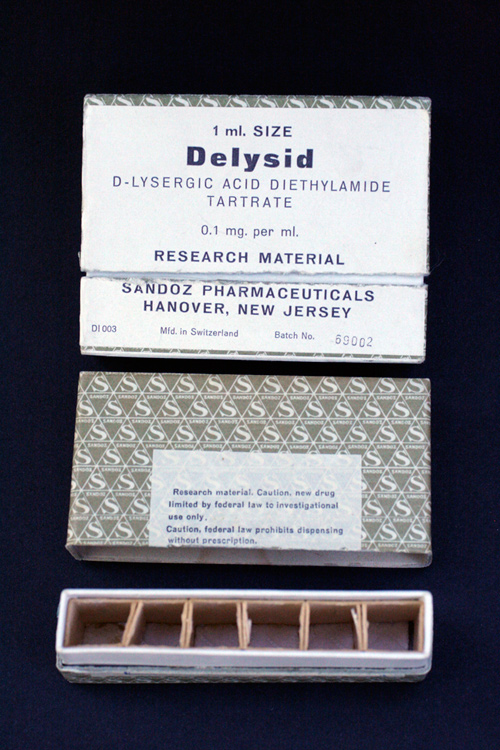
|
WORKING WITH PSYCHEDELICS...
By the end of 1956, Myron founded the non-profit California Foundation for Advanced Study, which transformed in 1960 into the International Foundation for Advanced Study. IFAS conducted investigations into the effects of LSD and mescaline, including studies looking into their potential for enhancing creativity. As public opinion began to turn against psychedelics, in part due to publicity surrounding the actions of Timothy Leary, Myron attempted to persuade Tim to reconsider the path ahead. But eventually the Controlled Substances Act of 1970 was enacted, the major psychedelics were placed into Schedule I, and government-approved human research largely ended....AND MDMA
On January 28, 1978, Myron took MDMA for the first time. The experience produced a "marvelous euphoria" and was a "wonderful introduction" to the compound,2 which was not illegal at the time. Indeed, MDMA was but one of numerous novel non-scheduled psychoactives "alphabetamines". Myron quietly began personal investigations into the effects of these drugs, until the Controlled Substance Analogue Act of 1986 put a damper on that research as well. After this, Myron shifted more focus onto his meditation practice, eventually studying under the Tibetan Buddhist Alan Wallace. He joined the Board of Directors for The Albert Hofmann Foundation, which had formed in 1988. And he began writing his autobiography, Thantos to Eros: 35 Years of Psychedelic Exploration, which was published in 1994.A WRITER AT HEART
Thantos to Eros was my introduction to Myron's life's work. I was impressed with his sincerity, dedication, and ability to voice the insights that psychoactive drugs could make available. I reviewed his book in my Psychedelic Resource List, a periodic newsletter I was publishing at the time, and sent Myron a copy of what I had written. We continued to correspond, and Myron kindly provide a back-cover endorsement when my newsletters were compiled into a book in 1996.In 1997, I helped copy-edit The Secret Chief, published by the Multidisciplinary Association for Psychedelic Studies, and worked with Myron to create an appendix of relevant resources for his book. My involvement with Myron and MAPS on this project led me to meet two individuals who became a couple of my best friends, and spawned several fruitful working alliances. Myron later contributed articles on the topics of the effects of psychedelics on creativity and sexuality for two special theme issues of the MAPS Bulletin that I co-edited with Sylvia Thyssen.
LECTURING AT CONFERENCES
By the end of 1997, Will Beifuss, Richard Boire, and I had invited Myron to speak at the first Mind States conference we produced at the International House in Berkeley, CA. Myron's presentation, "The Trained User: Deepening Meditation Practice and Forestalling Aging", was well-received by the 400 psychedelic enthusiasts in attendance. After hearing that Myron had passed away, I pulled out some old video tape from the conference, digitized it, and uploaded his talk to YouTube: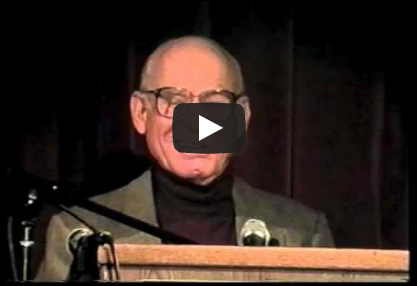
Myron returned as a Mind States speaker in 2001, where he read a commencement address that Albert Hofmann had prepared for the event. Myron also appeared on a "Panel of Elders" with Michael Horowitz, Laura Huxley, Rosemary Woodruff Leary, Cynthia Palmer, Ann Shulgin, Sasha Shulgin, and Huston Smith.
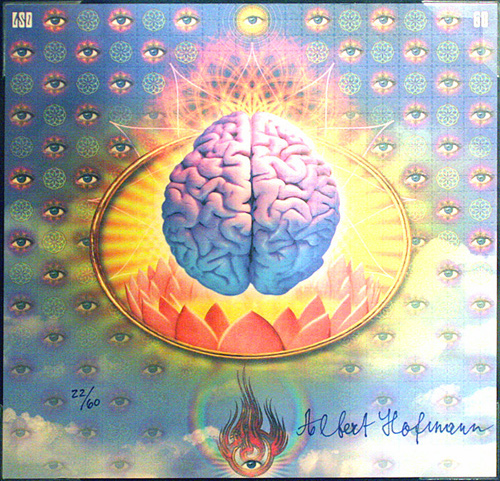
|
In conjunction with that gathering, I commissioned the artist Stevee Postman to create a blotter art design. I had the idea that a limited number of these sheets--maybe 250--might be autographed by Albert Hofmann and sold to help raise funds for MAPS and Erowid, who had recently scanned over 4,000 documents from Albert's collection of LSD- and psilocybin-related papers.
INTERACTIONS WITH ALBERT
Prior to 2003, I'd only had a few short communications with Albert. Therefore, it struck me that it might make more sense if Rick Doblin asked him if he'd be willing to sign the art. Rick had previously persuaded Albert to autograph 100 limited hardcover editions of The Secret Chief, since Albert had written the foreword for Myron's book. Surprisingly, Rick was unwilling to ask. He explained that he didn't think Albert would agree to sign any blotter art. According to vanity blotter maven Tom Lyttle, Rick related, Albert had previously autographed only 12 sheets of blotter, after which he refused to sign any more. Why Albert got cold feet was unknown. Rick speculated: Most of the blotters that Albert did autograph were subsequently also signed by Timothy Leary, so perhaps that had upset him; or maybe he just didn't want to project any association with illegal LSD. If I ended up contacting Albert myself, Rick advised that I ask for fewer than 250 signatures, since signing that many might feel daunting for a soon-to-be 97-year-old. In light of Rick's comments, requesting fewer autographs seemed like sound advice. My partner Will Beifuss proposed that I ask for 60, to reflect the number of years that had passed since Albert's first trip. I wrote to Albert and happily received his reply letting me know that he would sign the art. The fundraiser was a success, ultimately raising over $50,000 for the two organizations. (One sheet--which I dubbed "The Legends of LSD" blotter after additionally having Stanislav Grof, Ralph Metzner, Nick Sand, and Myron Stolaroff sign it--fetched a $10,000 donation for Erowid; not too shabby!)As we approach the 70th anniversary of Hofmann's first acid trip this year, I bring up this art because it evidenced for me of how easy it can be to forget some details of any story. Revisiting e-mails with Myron reminded me of the final twist. A couple of weeks after the blotter art signed by Albert was released, an online vanity blotter vendor proposed to Myron that he'd like to offer signed blotter as a fundraiser for The Albert Hofmann Foundation, if Albert would autograph a new design. When Myron called to try and arrange the signing, Albert told him that the police had notified him that he'd broken the law by signing blotter art, because such art encouraged the use of illegal drugs. Myron didn't think that there was any further problem for Albert, but the good doctor wouldn't be signing any more blotter. It made me sad to think that Swiss cops would really hassle a 97-year-old man over autographing artwork, and I asked Myron to express these feelings--and again, my thanks--to Albert the next time they spoke. Myron assured me that he'd pass along my gratitude to Albert for his previous cooperation.
WRITING TO IMPROVE SOCIETY AND SELF
As I got to know Myron better over the years, I found him to be someone who cared deeply about the world and the welfare of humanity. The vast harms inflicted onto society by the drug war mentality, which greatly pained him, occasionally inspired Myron to pen anti-prohibitionist op-eds. Like many of us, he was appalled by the obscene amount of resources our government funnels into producing weapons of mass destruction. Myron's book-length manuscript--a piece of fiction addressing these topics titled To Foil Armageddon--remains unpublished.Writing was a part of Myron's self-directed therapy. His dedication to capture on paper the experiences he'd had was impressive. When a mutual friend visited Myron once, and they decided to have an MDMA trip together, Myron got out his notepad and asked what their goals would be. Our friend suggested, "Well, Myron, I think that our goal should be for you to put away the pen and paper, and the only thing we are going to do this time is have hedonistic fun with no concern at all about trying to describe the experience or save any insights for later." The friend, who suspected that this approach was infrequently taken by Myron, said that Myron went along with the plan and had a great time.
Although Myron was sometimes fairly hard on himself, this was in part due to his feeling that everyone had the potential for improvement. On the flip side, when it came to how he treated others, Myron was undoubtedly one of the sweetest people I have known: a mensch and a bodhisattva rolled into one. He took the time to respond to folks who had questions or needed help, and he really tried to actively listen to others. One never felt rushed, as though he had something more important to tend to, when interacting with Myron.
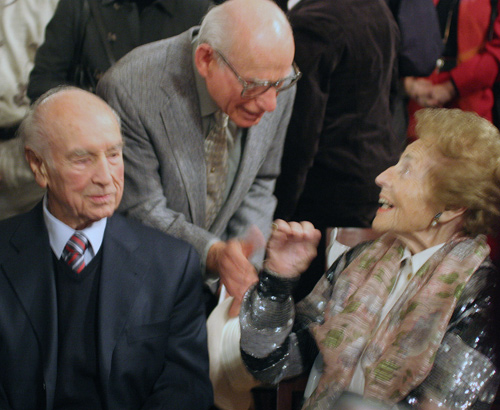
|
MEMORY FALTERS...
Other than a visit to my home from the Stolaroffs in 2003, I didn't see Myron again until 2006. We'd both been invited to present in Basel at "LSD: Problem Child and Wonder Drug", which celebrated Albert Hofmann's 100th birthday. I was honored to have the opportunity to finally thank Albert in person for his help with the fundraiser, and for his inspiring life's work. Spending some time with Myron at the conference, he mentioned that his memory wasn't what it used to be. It was a comment I'd heard him make before. But it never struck me as being entirely accurate when he'd previously brought up the topic. Myron clearly had an amazing memory; he was a wonderful storyteller, providing all manner of descriptive detail about people and places from events that happened many years in the past. It was true that he occasionally forgot a name; but he would always say, "Well, it will come to me in a moment. I'm afraid that my memory isn't what it used to be." And then--like a Swiss train traveling in an alternate dimension, where time runs exactly one minute slower--he would recall the person's name that he'd forgotten and insert it into the conversation. Indeed, I'd seen him do this enough times that it seemed like some sort of Jedi mind trick of delayed-but-still-reliable memory.There was talk of Myron possibly making it to Burning Man later that year, but for a number of reasons it wasn't to be. He would have been amazed. The last e-mails I got from him were in early 2007. I phoned in the fall, and he asked me to call back a bit later in the day, since his wife Jean would be home then. When I called again, he clearly didn't remember that we'd spoken about an hour earlier. Jean filled me in; his memory really was failing this time.
...FADES...
As dementia set in, Myron became increasingly quiet. Eventually, his vocabulary consisted mostly of the words "yes", "what?", and "hmmm". And yet, on the rare occasions that I'd see him, he seemed entirely happy. One of the struggles that Myron repeatedly faced (at least from my reading of his books and trip reports) was the parade of thoughts that danced through his head much of the time. It seemed clear to me that this was a reason why he found the practice of meditation to be so beneficial: it allowed him to quiet his mind and simply be present. Over the course of his final years when I visited Myron, it struck me several times that perhaps his seemingly limited mental activity should be considered, not as a prison, but as the peaceful freedom he had been seeking for much of his life. He no longer needed to live up to any expectations he had for himself. He could simply live....AND IS FOUND AGAIN
Ironically, during the years Myron largely stopped talking, I got to know him even better. This came about following a conversation I had with Lorenzo Hagerty, creator of the Psychedelic Salon podcasts. Back in 1998, Rick Doblin wrote about a 34-year follow-up study that he had done on Timothy Leary's experiment giving psilocybin to criminals in Concord Prison. Some time after Doblin's article was published in the Journal of Psychoactive Drugs, Myron lamented to me that, while the records from his IFAS research had been in storage for many years, just prior to him learning about Doblin's retrospective, he'd made the decision to dispose of these materials, thinking that there really wasn't any point in retaining them any longer. Of course, he changed his mind about that when he saw the excellent job that Doblin had done in following up on Leary's work, so many years later.However, during a visit Lorenzo made to the Stolaroffs, he discovered that not all of the materials had been destroyed. It was only most of the medical records that were disposed of. Many financial papers and other items had been kept, including a bounty of correspondence that Myron had written over the years. Lorenzo mentioned to me that someone really needed to preserve all of these materials. Since Tania Manning and I had been talking for a couple of years about videotaping the Shulgins and the Stolaroffs in discussion, we figured that we could take a look at Myron's papers during that visit to Lone Pine. We made the offer that any relevant materials might be scanned and made available via Erowid. This resulted in a vanload of boxes being transported to my house, and a good deal of time spent on cataloging Myron's archives. I've not yet had a chance to fully read most of the materials. With over 5,000 documents to process, one must of needs do a lot of skimming at first. But it has been impossible not to get sucked in at points. And as I have worked on the project, I have repeatedly been awed by the amazing mind that Myron possessed.
His organizational skills were top-notch, which has been extremely helpful during the process of cataloging the scanned materials. He often typed-up notes related to phone conversations that he'd had with assorted friends and colleagues, sometimes placing multiple copies into the relevant folders within his filing cabinets. After I came across a few of these, I remembered something that Myron had told me in person the day we first met each other: "Don't ever talk about illegal drugs on the telephone." While this struck me as entirely reasonable advice (and it still does), at the time he said it, I'm sure that I was imagining the possibility of government spooks recording incriminating utterings. It hadn't occurred to me that the individual I was speaking to might be writing down, typing up, and carefully filing away any remarks I had made!
Myron frequently printed copies of his e-mail correspondence, in order to also include these in his files. This may seem odd to a generation raised using computers, yet there are practical benefits from such an approach. It isn't only a matter of having a physical backup, if gear crashes. Eventually software or hardware changes to such a degree that old files are no longer easily readable on newer machines.

|
THE STOLAROFF COLLECTION
Myron's archive of journal and newspaper articles, correspondence, experience reports, photographs, audio recordings, and other ephemera, contains countless gems detailing the thoughts, efforts, and lives of those involved with contemporary entheogenic/psychotherapeutic research. From a 1955 Journal of Mental Science article about the new hallucinogen 3,4,5-trimethoxyphenyl-β-aminopropane to a 2008 letter from a former patient of Leo Zeff's writing to correct a probable error presented within The Secret Chief,2 the Stolaroff Collection spans over fifty years.Myron had a long, productive life. It isn't surprising that memories become fuzzy or forgotten, if someone lives long enough. Yet Myron's knack for documentation has allowed some of his memories to be saved for future generations to benefit from. It has been a pleasure to look more deeply into psychedelic history through the window of Myron's writings and collected materials.
Farewell, my friend.
- Although Thanatos to Eros gives the date of Myron's first LSD experience as April 12, a primary document from the Stolaroff Collection (linked to above) gives evidence for an April 16th date. However, that document is incorrect in suggesting that Myron had taken 20 mg of mescaline (a non-active dose) along with eight inhallations of carbogen in preparation prior to taking LSD; on that point, the drug consumed was methadrine, as is stated correctly in Thanatos to Eros.
- Zeff's former patient contacted Myron to thank him for writing The Secret Chief, which had brought him fond memories. He also wanted to let Myron know that Zeff likely did not have a PhD, which Myron had said was the case in his book.

